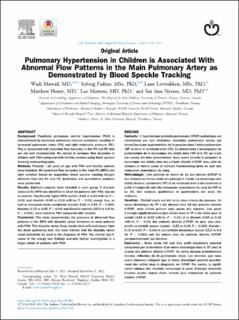| dc.contributor.author | Mawad, Wadi | |
| dc.contributor.author | Fadnes, Solveig | |
| dc.contributor.author | Løvstakken, Lasse | |
| dc.contributor.author | Henry, Matthew | |
| dc.contributor.author | Mertens, Luc | |
| dc.contributor.author | Nyrnes, Siri Ann | |
| dc.date.accessioned | 2023-05-21T20:40:27Z | |
| dc.date.available | 2023-05-21T20:40:27Z | |
| dc.date.created | 2022-10-26T12:36:12Z | |
| dc.date.issued | 2022 | |
| dc.identifier.citation | CJC Pediatric and Congenital Heart Disease. 2022, 1 (5), 213-218. | en_US |
| dc.identifier.issn | 2772-8129 | |
| dc.identifier.uri | https://hdl.handle.net/11250/3068405 | |
| dc.description.abstract | Background Paediatric pulmonary arterial hypertension (PAH) is characterized by increased pulmonary vascular resistance resulting in increased pulmonary artery (PA) and right ventricular pressure (RV). This is associated with disturbed flow dynamics in the PA and RV that are not well characterized. We aimed to compare flow dynamics in children with PAH compared with healthy controls using blood speckle tracking echocardiography. Methods Patients <10 years of age with PAH and healthy controls were included. We examined flow dynamics in the main PA (MPA) and right ventricle based on acquisition blood speckle tracking images obtained from the RV and PA. Qualitative and quantitative analyses were performed. Results Eighteen subjects were included in each group. A diastolic vortex in the MPA was identified in 16 of the patients with PAH, but not in controls. Significantly higher MPA systolic (4.84 vs 2.42 mW/m; P = 0.01) and diastolic (0.69 vs 0.14 mW/m; P = 0.01) energy loss, as well as increased vector complexity (systole: 0.21 vs 0.04, P = 0.003; diastole: 0.13 vs 0.05, P = 0.04) and diastolic vorticity (15.2 vs 4.4 Hz; P = 0.001), were noted in PAH compared with controls. Conclusion This study demonstrates the presence of abnormal flow patterns in the MPA with diastolic vortex formation in most patients with PAH. This diastolic vortex likely results from reflected waves from the distal pulmonary bed. Our data indicate that the diastolic vortex could potentially be used in the diagnosis of PAH. The clinical significance of the energy loss findings warrants further investigation in a larger cohort of patients with PAH. | en_US |
| dc.description.abstract | Pulmonary Hypertension in Children is associated with Abnormal Flow patterns in the Main Pulmonary Artery as demonstrated by Blood Speckle Tracking | en_US |
| dc.language.iso | eng | en_US |
| dc.relation.uri | https://www.sciencedirect.com/science/article/pii/S2772812922000896 | |
| dc.rights | Navngivelse 4.0 Internasjonal | * |
| dc.rights.uri | http://creativecommons.org/licenses/by/4.0/deed.no | * |
| dc.title | Pulmonary Hypertension in Children is associated with Abnormal Flow patterns in the Main Pulmonary Artery as demonstrated by Blood Speckle Tracking | en_US |
| dc.title.alternative | Pulmonary Hypertension in Children is associated with Abnormal Flow patterns in the Main Pulmonary Artery as demonstrated by Blood Speckle Tracking | en_US |
| dc.type | Journal article | en_US |
| dc.type | Peer reviewed | en_US |
| dc.description.version | publishedVersion | en_US |
| dc.source.pagenumber | 213-218 | en_US |
| dc.source.volume | 1 | en_US |
| dc.source.journal | CJC Pediatric and Congenital Heart Disease | en_US |
| dc.source.issue | 5 | en_US |
| dc.identifier.doi | 10.1016/j.cjcpc.2022.09.001 | |
| dc.identifier.cristin | 2065235 | |
| dc.relation.project | Norges forskningsråd: 322479 | en_US |
| dc.relation.project | Norges forskningsråd: 237887 | en_US |
| cristin.ispublished | true | |
| cristin.fulltext | original | |
| cristin.qualitycode | 1 | |

